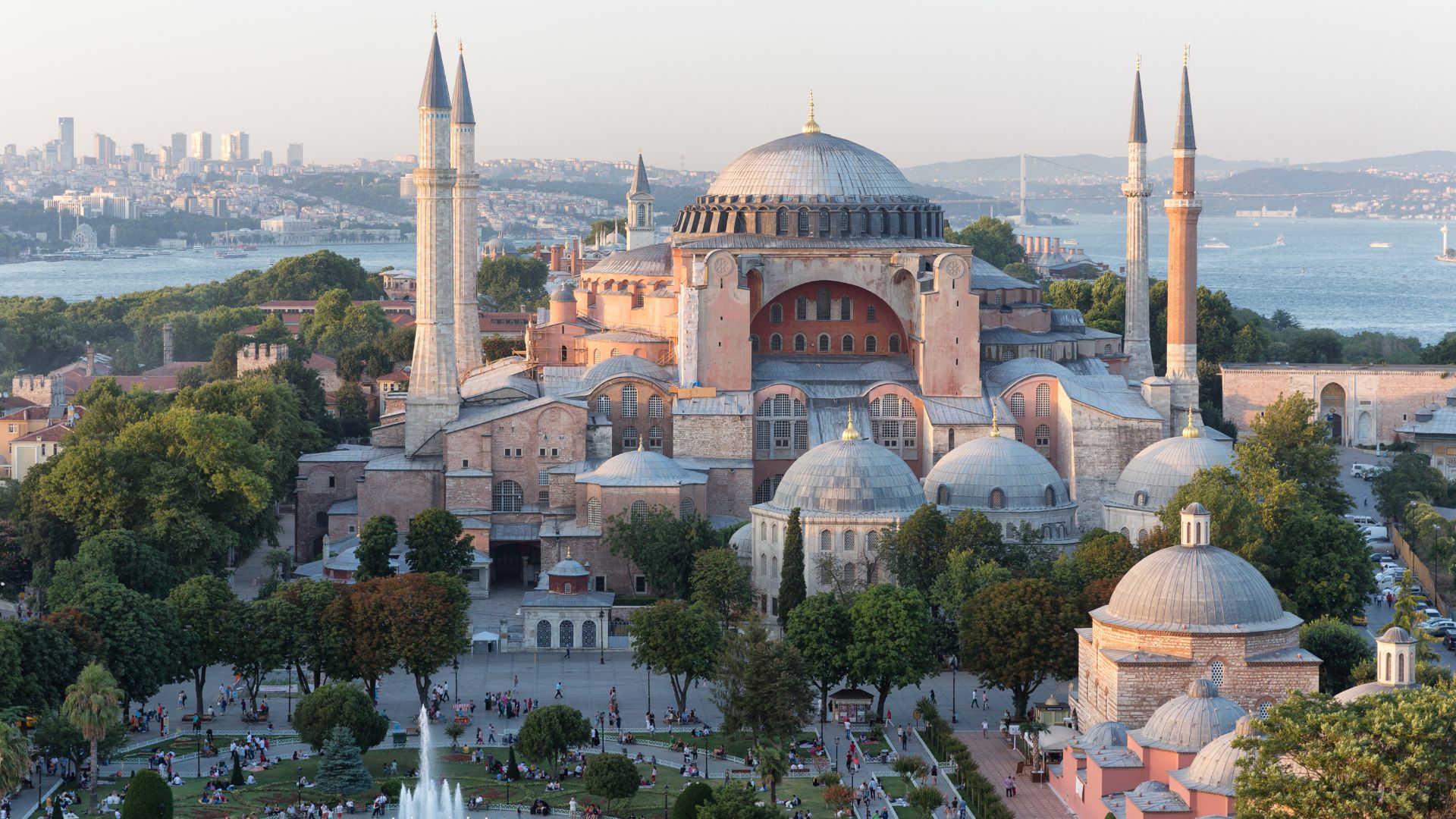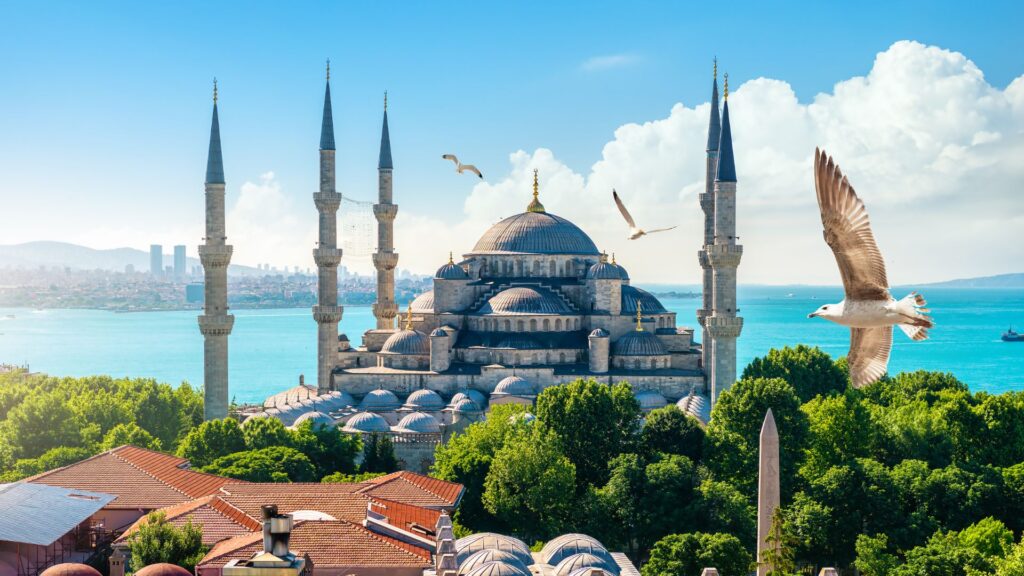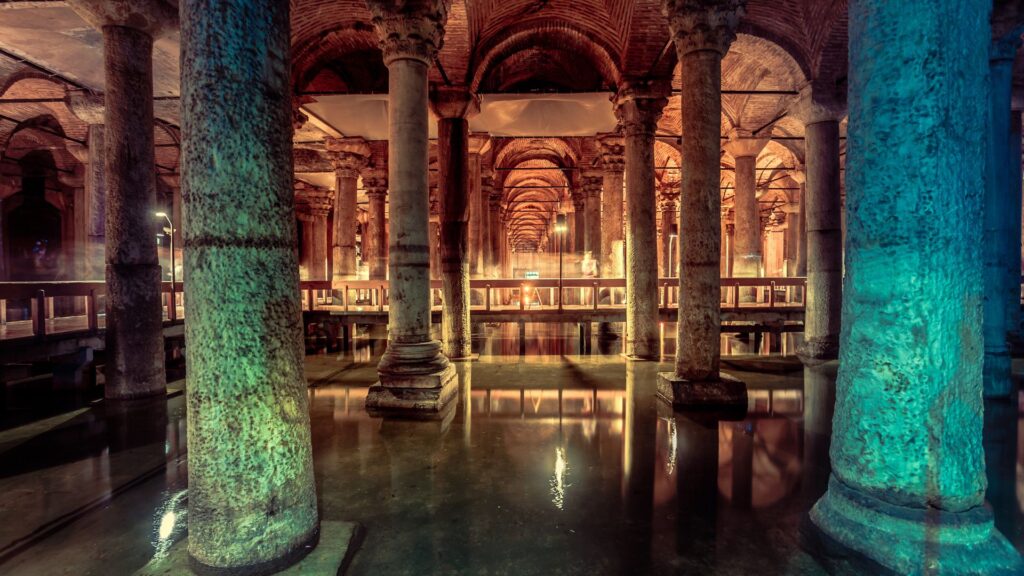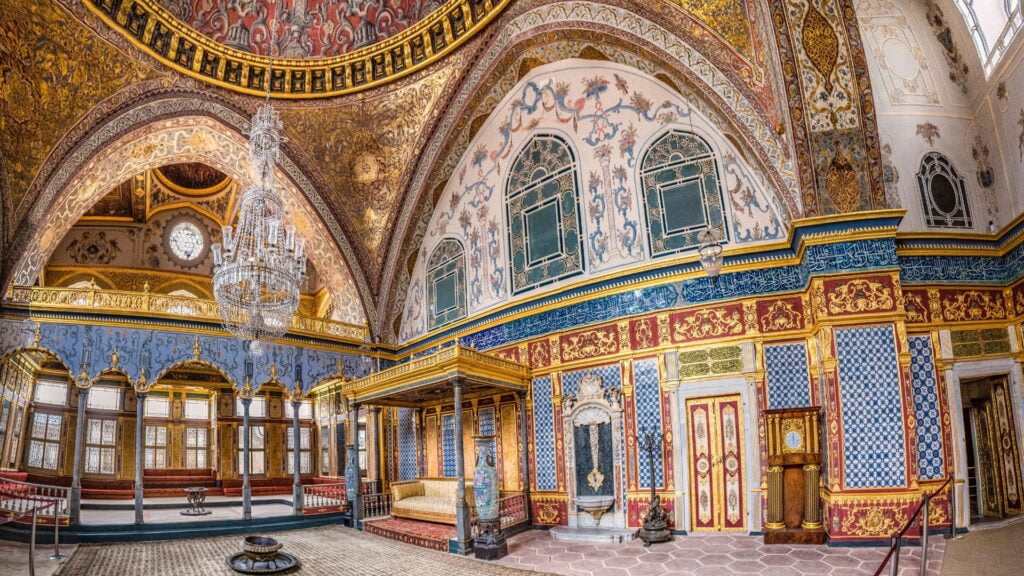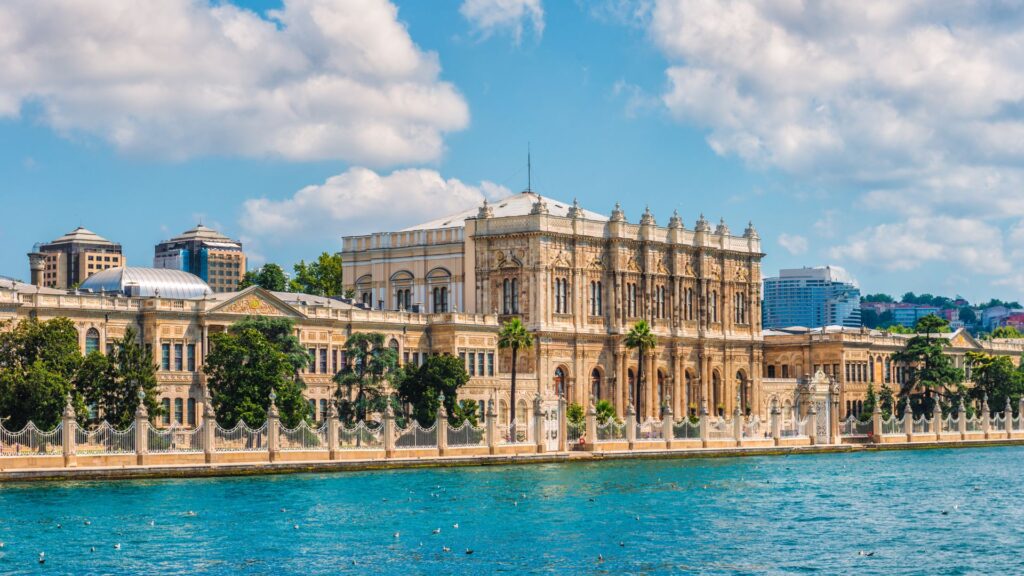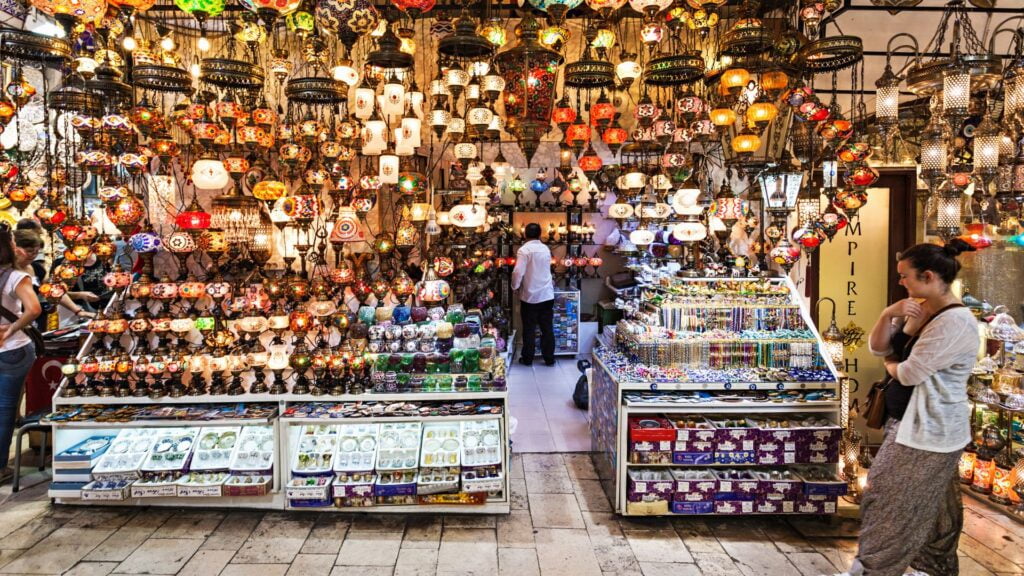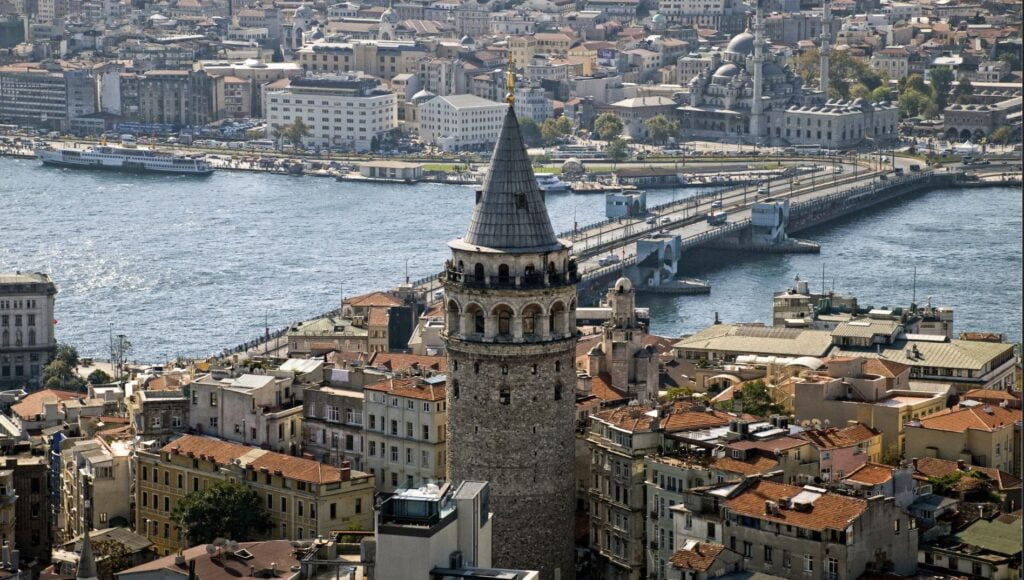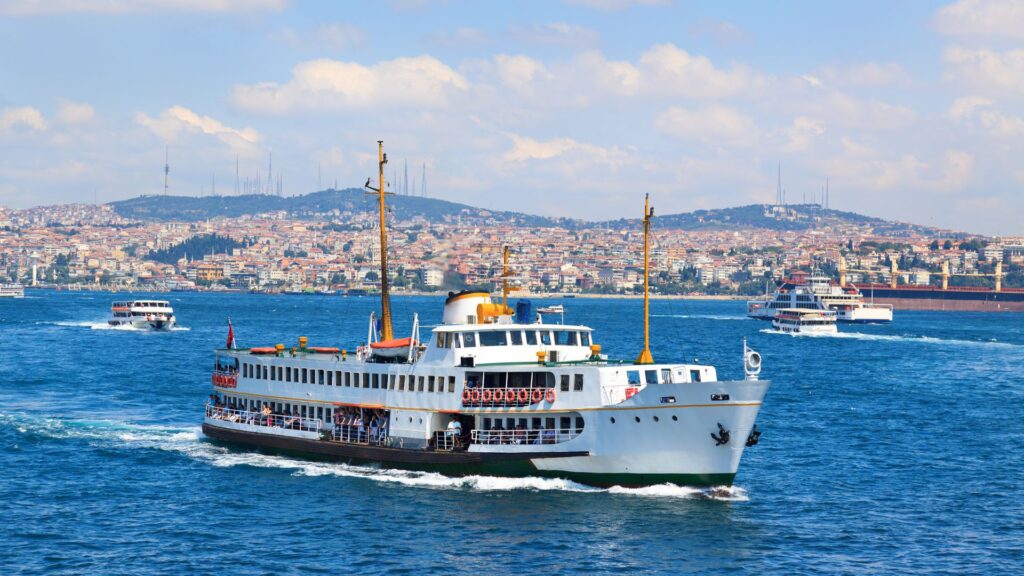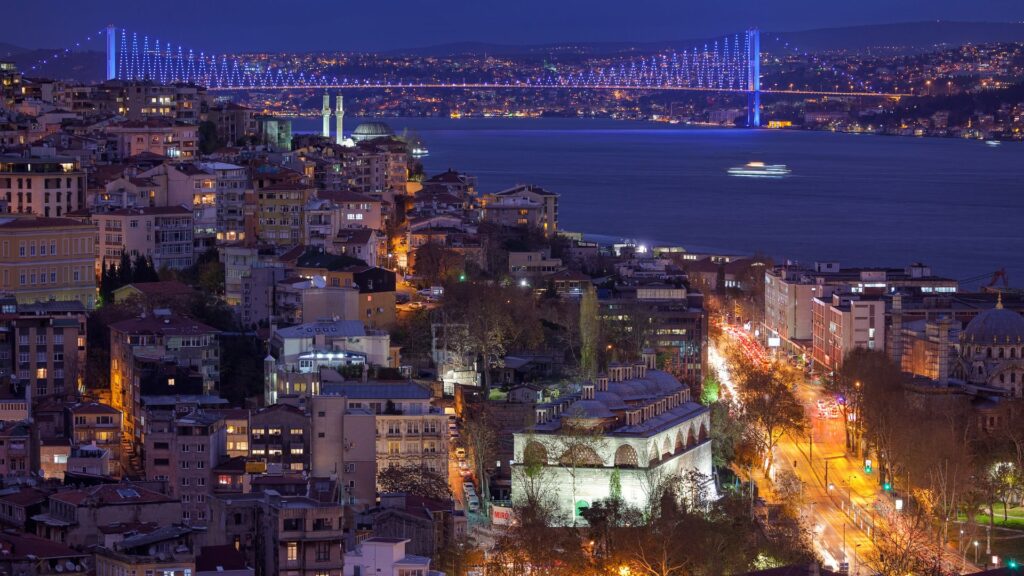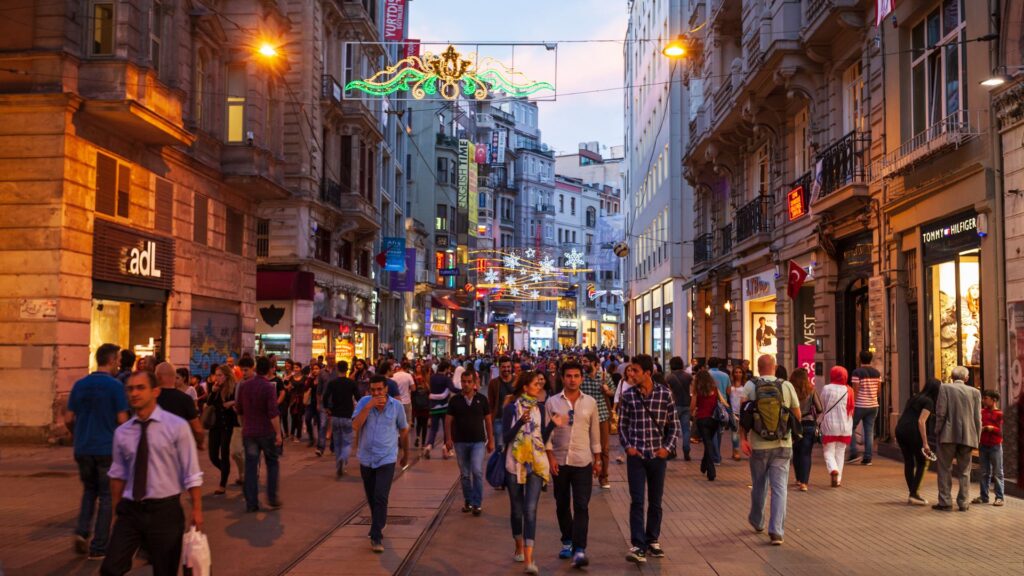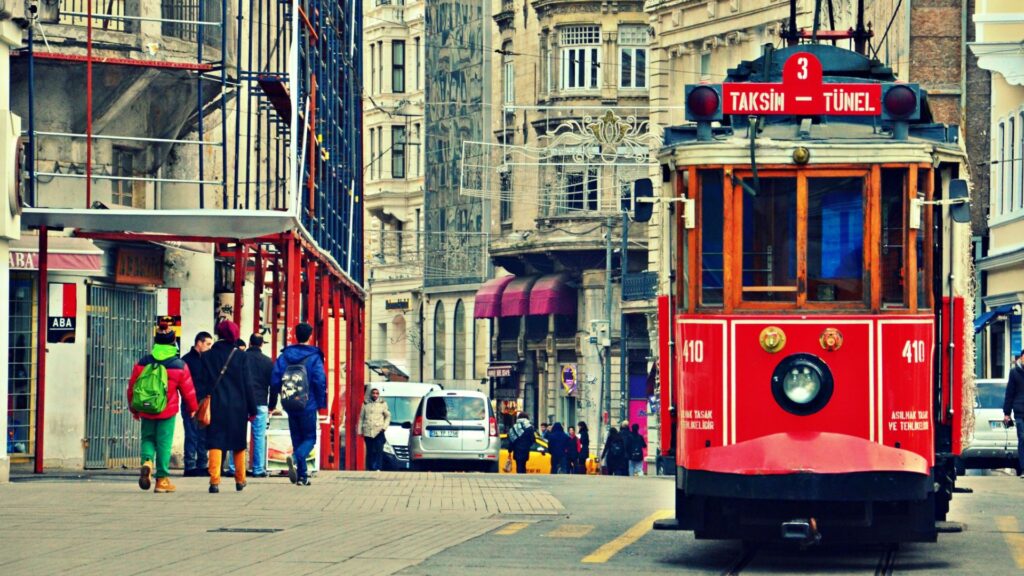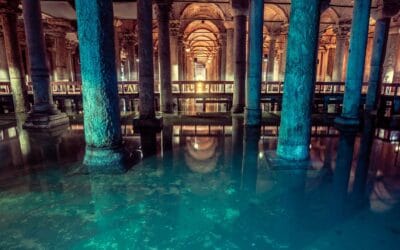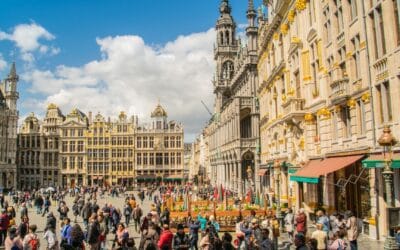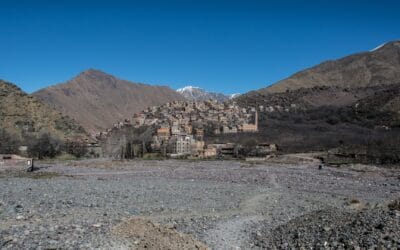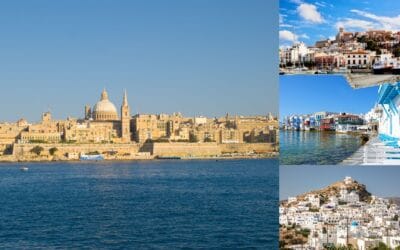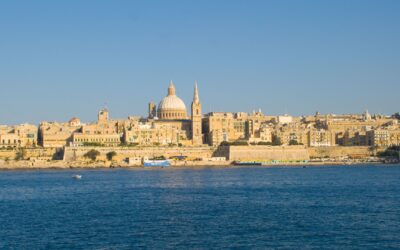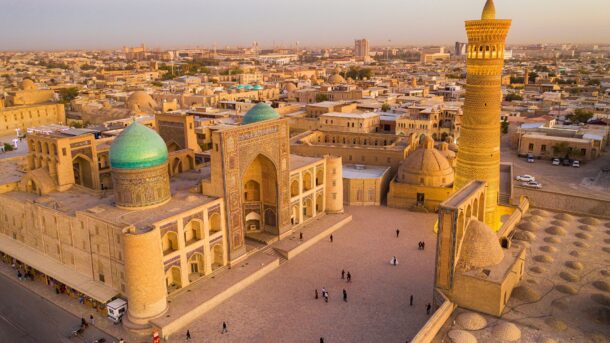Turkey is a large country with plenty of places to explore. If you only allocate a few days to Istanbul, you will not get to know most of the city but you should still be able to explore a lot of places most people call important. Even better, you might even have time to do some sunbathing and dance for hours, among other things. Let’s get you ready for a few days trip in Istanbul with a list of stuff to do for history nerds & night owls.
If you were a medieval traveler, you would have called the city Constantinople
Let’s start with some history, shall we? The city has a long one and its name has changed several times, most notably from Constantinople to Istanbul. While name changes are quite common in history, it’s hard to find an example where one of the most well-known cities in the world suddenly gets a new name. The word Istanbul is likely to derive from the Medieval Greek phrase “εἰς τὴν Πόλιν” (pronounced “is tim ˈbolin”), which means “to the city” and is how Constantinople was referred to by the local Greeks.
Constantinople is the city’s most famous historical name but not the oldest. The metropolis was initially known as Lygos and may have been founded by Thracians or Illyrians. You can still find a few remnants of its early days near today’s Topkapi Palace. The city was later known as Byzantion, with Byzantium being the name’s latinized form. Its most notable early period was under the rule of Constantine the Great in the 4th century, who transformed Byzantium into Constantinople, making it the new capital of the Roman Empire.
Constantinople gained a prominent role in the Byzantine Empire, being renowned for its strategic location that bridged continents and cultures. It thrived as a hub of commerce, culture, and diplomacy and played a central role in the spread of Christianity throughout the Roman Empire. The city saw immense growth and prosperity, especially under the reign of Emperor Justinian in the 6th century, who was responsible for constructing the city’s most famous landmark – Hagia Sophia.
In 1453, Constantinople fell to the Ottoman Turks, marking the end of the Byzantine Empire and the beginning of the city’s transformation into an Islamic cultural center. Under Ottoman rule, it was renamed Istanbul and became the most important city in the Ottoman Empire. The establishment of the Turkish Republic in 1923 made Ankara the new capital, yet Istanbul remains Turkey’s largest and most influential metropolis.
Today, Istanbul is a city of about 16.05 million. It is the most populous cities in Europe (if you ignore that half of it is in Asia) and one of the most populous cities in the world. If you think it’s a crowded city, you are right, and the 16 million annual visitors make it even more so.
Your quirky and not-so-quirky stuff-to-do list, in no particular order
Some people wake up at 6 a.m. while others sleep until noon. As such, I’m not going to suggest a schedule but rather give you a list of stuff you might wanna do if you decide that the city of many names is likely to be a (technically) European city break destination that might vibe with you. To make the best of the list, I recommend paying attention to the opening and closing hours for each of the gated places you want to visit and not forgetting about transportation considerations. Istanbul is a city of 5,343 square km (2,063 sq mi) where 15.6 million people live, meaning that going from one place to another may occasionally take significant time.
Wonder in Sultanahmet and adjacent areas
Sultanahmet is the historic center of Istanbul and includes several of the city’s main attractions. One of the district’s most famous streets is the Soğukçeşme, which is home to Ottoman houses, each named after a flower grown beside them. How cute. If you’re strongly into libraries, you may want to visit the street’s library/archive/museum, which possesses over 10,000 rare books.
Let’s take a closer look at some of the most famous landmarks in Sultanahmet and adjacent areas
Visit Hagia Sophia, also known as the most famous place in Istanbul
If you’ve looked at a few pics of Istanbul, you may have noticed that one building is particularly popular with photographers. That building is Hagia Sophia – arguably the city’s most representative landmark. If you are unsure how the building looks, take another look at this post’s main image.
Originally constructed in 325 AD, the current structure of Hagia Sophia was built between 532 and 537 AD during the reign of Byzantine Emperor Justinian I. It was initially a Christian cathedral, then converted into a mosque after the Ottoman conquest of Istanbul in 1453. In 1935, during a period of secularization, it was converted into a museum, and in 2020, with an increase in governmental religious conservatism, it was redeclared a mosque. Quite obviously, these transformations represent the social, cultural, and political changes that the land we call Turkey has experienced throughout centuries.
The mosqueis known for its massive dome, measuring 32 m (105 ft) in diameter, which was considered a marvel of its time. The interior contains Christian mosaics and Islamic calligraphy, as well as columns and marbles sourced from various ancient sites.
The visiting hours for Hagia Sophia are from 09:00 am to 7:30 pm, meaning that even if you have trouble waking up in the morning you may still manage to visit it. Note that the last entry for tourists is at 7:30 pm, after which the upper floor galleries reserved for you, the tourist, are closed. If you are a foreign tourist and want to visit the upper-floor galleries, you have to pay around $27 (€25).
Non-Muslim visitors are allowed to enter Hagia Sophia. The building is also open to foreign Muslim visitors for prayer throughout the day, and following congregational prayer, the building is evacuated, and only Turkish citizens can enter the rest of the time.
Go to the nearby Blue Mosque, also known as Sultan Ahmed Mosque
The apparently second most famous mosque in Istanbul was built between 1609 and 1616 by Sultan Ahmet I. The Blue Mosque is notable for its six minarets –tall, slender towers with a balcony from which muezzins call. The building was criticized for matching the number of minarets at the Kaaba mosque, in Mecca. To address criticisms, Sultan Ahmet I ordered the construction of a seventh minaret at the Kaaba.
The Blue Mosque and birds
The mosque is an example of the fusion of Ottoman and Byzantine architectural styles and was designed to rival the Hagia Sophia in size and beauty. The interior is decorated with over 20,000 handcrafted blue Iznik tiles, hence the name “Blue Mosque.” It features five main domes, eight secondary domes, and over 200 stained glass windows that illuminate the interior. The central dome is 43 m (141 ft) high and 23.5 m (77 ft) in diameter. The mosque’s design ensures that the imam can be heard throughout the building, even when it’s crowded.
The Blue Mosque is open from 08:30 am to 17:30 pm. It is, however, closed during prayer times, which can vary throughout the year. The best time to visit is typically in the morning, from 08:30 to 11:30 am but do check the official prayer time schedule to plan your visit accordingly.
If you’re on a budget, or simply an excessive saver, you’ll be glad to know there is no entrance fee for the Blue Mosque. You do not have to be a Muslim to visit the mosque but you cannot get inside during prayer times.
If you want to visit Hagia Sophia and the Blue Mosque with a single guided tour, the Blue Mosque & Hagia Sophia Guided Tour w/ Tickets has good reviews.
Go underground at the Basicila Cistern
There may be around 200 cisterns in Istanbul. Its most famous one is called Basilica Cistern due to its location under a larger public square which was called Stoa Basilica. Historical records reveal that this basilica cistern featured gardens encircled by a colonnade, with views towards the Hagia Sophia. As per the writings of ancient historians, Emperor Constantine initially constructed this edifice. It was later extensively renovated and expanded by Emperor Justinian following the catastrophic Nika revolts of 532, which left the city in ruins. After the Ottoman conquest of Istanbul in 1453, it continued to provide water for a short period before being forgotten and then rediscovered in the 16th century by the French traveler Petrus Gyllius.
Inside Basicila Cistern. Spooky? I don’t think so
This original underground chamber is approximately 138 m (453 ft) long and 65 m (213 ft) wide, covering an area of about 9,800 square m (105,000 square ft). It can hold 80,000 cubic meters (2,800,000 cubic feet) of water. This underground water reservoir is supported by 336 marble columns, each standing at a height of 9 m (about 30 ft). These columns are arranged in 12 rows of 28 columns each, covering a giant rectangular area of 9,800 square m (about 105,489 square ft). The columns feature a mix of Corinthian and early Byzantine styles and are said to provide an atmospheric lighting. The cistern’s walls are lined with a special firebrick, and it has a 52-step stone staircase for access.
The Basilica Cistern is most famous for the two Medusa heads at the base of two columns, placed upside down and sideways. While the exact reasons for this positioning remain a subject of speculation, it’s believed that placing them this way was meant to negate their power to turn people to stone. They are thought to have been brought to Istanbul from a pagan temple in Greece or Rome and placed in the cistern, either as a protective symbol, for decorative purposes, or as a tribute to the mythological figure of Medusa herself.
The Basilica Cistern is also popular with the movie industry. The cistern was featured in the 1963 James Bond film “From Russia with Love,” where Bond, James Bond, sails through the underground cistern to reach a secret door.
The cistern is open every day from 09:00 am to 18:30 pm. For those into unusual entertainment locations, there is a “Night Shift” from 19:30 pm to 22:00 pm, during which special music concerts and events take place. The entrance fee is around $22 (€20).
You can also visit Basilica Cistern with a guided tour. Some of these tours will only take you the the cistern while others also have other landmarks included, such as Hagia Sophia.
If you’re still not sure this place is for you, here is some extra intel on why you should go to Basilica Cistern.
Take a look at the Topkapi Palace
What should a sultan do after conquering a city? Build a palace to show who’s in charge now, some old-school folk would say. And this is what Sultan Mehmed II did in 1453. The Topkapi Palace, a UNESCO site, served as the administrative center and primary residence of the Ottoman Sultans for nearly four centuries. After the 17th century, the palace gradually lost its importance as the sultans preferred the newer palaces along the Bosphorus. In 1856, Sultan Abdulmejid I moved the court to Dolmabahçe Palace. In 1924, following the end of the Ottoman Empire, Topkapi Palace was transformed into a museum under the administration of Turkey’s Ministry of Culture and Tourism.
Topkapi Palace is an example of Ottoman architecture, comprising a series of courtyards, the main palace, and several ancillary buildings. Like many things in Istanbul, the palace complex displays a blend of Islamic, Byzantine, and Ottoman architectural styles. It features elegant pavilions, ornate courtyards, halls, and pretty gardens.
Inside the pretty Topkapi Palace
The palace is home to several historical artifacts, art, and treasures. This includes the Imperial Treasury, which houses a collection of objects made from gold, silver, precious gems, and the famous Spoonmaker’s Diamond (one of the largest diamonds in the world), and the Topkapi Dagger (a dagger with three large emeralds on the hilt and a series of smaller precious stones set in its sheath). The palace’s Harem draws particular interest, as it’s the place that housed the sultan’s mother, wives, concubines, children, and other people. With more than 400 rooms, the harem certainly had enough space for specific people or purposes.
The entrance fee to Topkapi Palace is around $80 (€75). The price includes access to all parts of the palace, including the Harem Rooms and Hagia Irene. The palace is open every day except Tuesdays, from 9:00 AM to 6:00 PM. It’s recommended to purchase tickets online to avoid long queues and potentially lengthy waits for entry.
Guided tours of the Topkapi are also available, with some also including visits to other of the landmarks I mentioned earlier.
Find relics from ancient civilizations at the Istanbul Archeological Museum
The Istanbul Archaeological Museum, founded by Osman Hamdi Bey, a painter and intellectual, was opened to the public in 1891 and it is notable for being Turkey’s first museum. This building, completed between 1897 and 1901, was designed by the French architect Alexandre Vallaury in a Neo-Classical style and is located within the walls of the Topkapi Palace complex.
The museum has one of the largest collections in the world. The museum complex includes three sections: the Archaeology Museum, the Museum of the Ancient Orient, and the Tiled Pavilion. The Alexander Sarcophagus, discovered in the necropolis of Sidon, Lebanon, is a highlight of the museum, dating back to the 4th century BC, and is believed to have been made for Alexander the Great’s father. Additionally, the Treaty of Kadesh, one of the oldest written treaties in the world, is also housed in the museum.
The museum is open every day except for certain public holidays. During summer (April 1 – October 31), it’s open from 09:00 to 20:00, and during winter (November 1 – March 31), from 09:00 to 18:30. The entrance fee is around $19 (€18 ) and includes admission to all three museums within the complex.
Visit the Dolmabahce Palace
Built between 1843 and 1856 during the reign of Sultan Abdülmecid I, Dolmabahçe Palace is understood to be a symbol of the empire’s modernization efforts. It served as the administrative center of the Ottoman Empire and later as the Presidential Residence after the Republic of Turkey was established.
The Dolmabahce Palace
Dolmabahçe Palace spans an area of 45,000 sq m (484,376 sq ft) and comprises 285 rooms, 46 halls, 6 baths, and 68 toilets. Its architectural design is a mix of Baroque, Rococo, and Neoclassical styles merged with traditional Ottoman architecture. The structure’s layout is divided into two primary sections: the Selamlık (public representation rooms) and the Harem (private residential area), with the grand Ceremonial Hall beautifully separating the two areas. The palace’s Ceremonial Hall boasts the world’s largest chandelier, made of crystal, and is renowned for its intricate details, including its Crystal Staircase, made from Baccarat glass.
Dolmabahçe Palace is open for visitors from 9:00 AM to 4:00 PM every day, except Mondays and Thursdays. Photography is not allowed inside the palace. Not cool! The entrance fee is around $57 (€52).
Feel free to checkout some Dolmabahçe tours. It may be worth pointing out that in one of these you can combine a tour of the palace with a sunset yacht cruise.
Take some pics in the Sultanahmet Square
Adjacent to the Egyptian Obelisk of Theodosius you will find the 4th-century Stone of Million pillar ruin. This site is a remnant of late Roman or Byzantine architecture. Historically, it played a unique role as the reference point for measuring all distances within the Byzantine Empire, earning it the nickname “Milliarium Aureum” of Constantinople. While only a fragment of the original structure remains today.
One of the things you will likely want to photograph at the square is the Egyptian Obelisk of Theodosius. This 19.6 m structure (62 ft) was initially erected for Pharaoh Thutmose III to commemorate his victory over the Mitanni around 1450 BC. In 357 AD, the Roman emperor Constantius II (337–361 AD) oversaw its relocation from the grand temple of Karnak (near Luxor, Egypt), along with another obelisk, via the Nile River to Alexandria. A second obelisk was subsequently erected on the spina of the Circus Maximus in Rome in the same year and is now recognized as the Lateran Obelisk. The obelisk that eventually became known as the Obelisk of Theodosius remained in Alexandria until 390 AD when Theodosius I (379–395 AD) decided to move it once again, this time to Constantinople, where it was raised on the spina of the Hippodrome.
Do some shopping (and bargaining) at the Grand Bazaar
The Grand Bazaar in Istanbul, known as Kapalıçarşı in Turkish, is one of the largest and oldest covered markets in the world. It spans over 30,700 sq m (330,000 sq ft) and comprises 61 covered streets with over 4,000 shops.
A single store at the Grand Bazaar looks overwhelming enough
If bazaars are your thing, then I assume you will not want to miss the opportunity to explore the world’s largest one. As you might suspect, trekking this giant market will involve seeing things such as oriental carpets, antiques, textiles, jewelry, and traditional Turkish sweets and spices, among other things. Different covered streets specialize in different types of merchandise, which should mean you will be able to distribute your time in a way that won’t make you spend half of the day in it.
The Grand Bazaar is open every day from 8:30 to 19:00, except on Sundays and the first day of religious holidays. Unless you love crowds, it’s best to avoid mid-day when the bazaar is most crowded.
Last but not least, if you’ve ever been to a bazaar before, you know that bargaining is an integral part of the shopping experience. Unless you are in a hurry, don’t accept the price you are being offered and test your haggling skills. And if you are to haggle, consider doing it like one of Istanbul’s weirdest tourist.
Go to the Chora Church
Now that you’ve visited some of the most famous landmarks around Sultanahmet, you are ready to get father away from the historical city and visit the The Chora Church, also known as Kariye Mosque. This historical site built initially in the 4th century and rebuilt in the 14th century. The name ‘Chora’ means ‘countryside’ in Greek, which refers to its original location outside the walls of Constantinople. While still referred to by the word church, the site became a mosque after the Ottoman conquest, was later converted into a museum, and now is once again a mosque. Sounds familiar?
The building is known for its Byzantine art, particularly its frescoes and mosaics. It displays typical Byzantine architectural elements, including a main dome, several smaller domes, and a narthex (entrance hall).
The site is open to visitors daily from 09:00 AM to 04:30 PM and the entrance fee is only around $3.50 (€3.20).
Note that the Chora Church is situated in the Edirnekapı neighborhood of Istanbul, being a bit off the beaten path compared to other tourist attractions in the city, located in the western part of the historic peninsula. Reaching the building can be a bit tricky as it’s not on the main tram or metro lines so buses or taxis are the best options.
In case you wonder, there’s a well-reviewed guided Chora Church tour for you.
Climb the Galata Tower
The medieval tower known as the Galata Tower was originally built as a watchtower and lighthouse during the Byzantine era, most likely around 507 AD during the reign of Byzantine Emperor Justinian. The current tower, however, was constructed by the Genoese in 1348 and has served various roles over the centuries, including as a prison, observatory, and fire tower.
The tower stands at a height of 66.9 m (219 ft), offering panoramic views of Istanbul from its observation deck. One of its most notable features is its incredibly thick walls, measuring about 3.75 m (12.3 ft), which were essential for its role as a fortress. The tower’s cylindrical structure topped with a conical cap adds to its distinctive appearance.
Galata Tower is linked to the legendary story of Hezarfen Ahmet Çelebi, an Ottoman scholar, who purportedly flew from the tower using self-made wings in the early 17th century. It should go without saying, don’t try this at home, at the Galata Tower, or anywhere else.
The Galata Tower
Visitors can explore a small museum within the tower and, if you’re hungry, there’s a restaurant and a café.
Keep in mind that you might have to queue twice – once for buying tickets and then for entry. The tower is open daily from 08:30 in the morning until 23:00 in the evening. The entrance fee is around $35 (€32).
Take a (Turkish) bath at Süleymaniye Hamami
If you know a few things about the Ottoman world, you know that it is famous for its Turkish baths. Similar types of public baths can be found all over the Muslim world and are inherited from the model of the Roman thermae. The Süleymaniye Hamam in Istanbul is a notable example of a Turkish bath, designed and built between 1550 and 1557 by the Ottoman architect Mimar Sinan. The structure is part of the larger Süleymaniye Mosque complex. The hamam, over 470 years old, played a significant role in Ottoman culture and was frequently visited by its sultans.
Your traditional Turkish bath experience at Süleymaniye Hamam will involve three main steps – relaxation in the hot room, a full-body exfoliation followed by a soap massage, and a cooldown period. Sounds like fun, right? The entire experience will last for about 90 minutes minors must be 12 years old or older to use the services.
The bath is open every day between 10 AM and 10 PM. The entrance fee is about $55 (€50) and you can only pay in cash.
Try traditional Turkish food & drinks
Turkish cuisine is quite well-known at the global level, especially in European countries where large Turkish communities reside. Perhaps the most well-known dish is Kebab, which takes many forms, including the Adana kebab and İskender kebab. Dishes such as the Arab shawarma, Greek gyros, Mexican al pastor, and Canadian donair are derived from Kebab.
Among the vegetable-centric dishes, dolma, featuring stuffed vegetables like grape leaves, stands out as a popular category. The most famous pastries are known as Borek. These are made from phyllo dough and are filled with spinach, cheese, and other ingredients.
For breakfast, many enjoy Menemen, a dish composed of eggs, tomatoes, green peppers, and a medley of spices. On the streets, Dürüm takes the spotlight as a wrap, typically filled with kebab and vegetables. The most famous Turkish dessert is the Baklava. This sweet pastry consists of layers of filo dough filled with a blend of nuts and syrup.
Finally, Turkey is not only a place where there’s a lot of tea but also a distinctively prepared coffee. The Turkish Coffee is made by boiling finely ground coffee beans with water and usually sugar, in a special pot called a cezve or ibrik. This method produces a strong and thick coffee which I think many would regard as better than most other types of coffee.
Take a cruise on the Bosphorus
You might have heard that Istanbul is a transcontinental city, with about half of the city being located on the European continent, and the other half on the Asian one. The two continents are separated by the Bosphorus Strait and you can use a ferry service to move from one side to the other.
This may be your future cruise ship
Known as both the Bosporus Strait and İstanbul Boğazı in Turkish, this natural waterway holds global significance. Found in Istanbul, Turkey, it links the Black Sea to the Sea of Marmara, serving as a continental boundary between Asia and Europe. Additionally, it separates Anatolia from Thrace and stands as the world’s narrowest international navigation route. The Bosporus has a maximum length of 31 km (19 mi), a minimum width of 700 m (2,300 ft), and reaches a maximum depth of 110 m (360 ft).
There are plenty of Bosphorus cruise options to consider, so it’s probably a good idea to take a close look at some of them and decide which one is best for you. Regardless of the option you choose, you will typically pass by historical landmarks like the Hagia Sophia, Topkapi Palace, and the Maiden’s Tower. If you have already seen all of these, you are perhaps more likely to find the evening cruises the most scenic of all.
Party all night in Taksim or other hotspots for night owls
Istanbul is also that place where you can experience a nightlife that blends Western elements with Middle Eastern ones. A single night in the city can be your moment to try some dancing moves on traditional Turkish music while also returning to your presumably comfort zone by exploring some mainstream clubs and bars.
Istanbul at night
Much of the city’s nightlife takes place around the Taksim-Beyoğlu-İstiklal Street-Tunnel corridor, as well as Beşiktaş Cihangir, Etiler, Bebek, Galata, Ortaköy, Nişantaşı, and Levent on the European side. On the Asian side, the nightlife hotspots include Bağdat Street, Kadıköy, Moda, and Suadiye.
Of all of these, Taksim is for sure the city’s epic center of nightlife, where you can find pubs, clubs, restaurants, street food, and traditional Turkish taverns. The most crowded part of Taksim is the Istiklal Street. This shopping avenue stretches for nearly 2 km (1.2 mi) and is a blend of historical bazaars, boutiques, nightclubs, bars, cafes, and restaurants.
Istiklal Street on an average evening
Navigating a large city at night comes with its challenges, especially if you are by yourself or the people around you are as lost as you. Worry not, pub crawls do exist in Istanbul and I know two that have mostly very positive reviews. The first one has the poorly inspired name of #1 Rated Istanbul Party Pub Crawl + a few more words and the other one is called Istanbul Pub Crawl Big Night Out. Regardless of which option you take, you will be taken to several locations in the Taksim area. No surprise here.
Take a sunbath at one of Istanbul’s beaches
You “heard” that right, Istanbul has beaches. While not typically associated with seaside vacations, the city can be your place-to-go if you want to combine a city break with a beach break.
One of the city’s beaches is Caddebostan Beach. This beach gives you access to shallow waters and can be reached by direct ferries from Kabataş and Kadıköy ferry terminals. The travel duration depends on your starting point within Istanbul but is relatively short since it’s within the city.
Another option to consider is Kilyos Beach. The travel time by car is about 45 minutes to an hour, and public buses are also available from the city center.
Yet another option is Florya Güneş Beach. Located in the European district of Bakırköy, it can be reached in less than an hour from the city center using the Marmaray to Florya Station. An entrance fee is charged, which includes amenities like a sunbed, umbrella, and showers.
For a more tranquil experience, you may be willing to go as far as 80 km (50 mi) east of Istanbul to reach Şile or Ağva Beach. The drive takes about 90 minutes to 2 hours, depending on traffic. Public transportation options include buses and dolmuş.
Perhaps the coolest option to consider is a trip to the Princes’ Islands. These islands are located in the Marmara Sea and are accessible via a ferry ride of one to two hours from several ports in Istanbul (including Kabataş, Beşiktaş, and Kadıköy). Büyükada is the largest and most popular island but you may want to research each of them before deciding to go to one or the other.
Good places to sleep in Istanbul
A city as large as Istanbul will have, of course, thousands of accommodations. The Sultanahmet area is a great location, especially if you plan to visit most of the landmarks located in the area. If you want to be close to where the nightlife is, then it is probably best to stay somewhere around the Taksim-Beyoğlu-İstiklal Street-Tunnel corridor, although that also depends on where you plan to go.
Beşiktaş and Ortaköy can also be options on the table if you want to see more of the local life and to be close to the Bosphorus. For something more bohemian, you can consider Kadıköy. Nişantaşı, on the other hand, would be the place to go if you want to stay in an upscale neighborhood with high-end shopping and luxurious hotels.
In my opinion, for a short stay, it’s best to stay in the central districts, so that you don’t have to spend a lot of time using public transportation. Remember, Istanbul is a really big city! Also, if you are going to spend much of the night exploring the city, there’s arguably no better accommodation than one located very close to your entertainment avenues.
A few things about Istanbul’s public transportation
Istanbul has a diverse public transportation system but it may occasionally be overwhelmed by the very large number of people using it.
The T1 Tram Line connects Bağcılar to Kabataş, passing through key locations like Sultanahmet, Taksim, Dolmabahçe, and Eminönü, and operates daily from 6:00 AM to midnight, with each ride costing around $0.81 (€0.75). However, I recommend taking the T2 Line, which runs along İstiklal Street from Taksim Square to the Tünel funicular station near Galata Tower. The line is available from 7:00 AM to 10:45 PM on weekdays and starting at 7:30 AM on Sundays. The reason I’m recommending this line is because it involves a ride on one of the city’s so-called “nostalgic” tramways, which are two heritage tramlines that are quite vintage.
Taksim- Istanbul’s old-school tram
The metro network includes 133 stations. A standard metro trip costs approximately the same as the tram, $0.81 (€0.75). The Marmaray Line, a key component of this network, operates daily from 6:00 AM to midnight, connecting the European and Asian sides of Istanbul. The M1A Line provides a direct link from Yenikapı to Atatürk Airport, while the M1B Line connects Yenikapı to Kirazlı. The M2 Line, the most frequented, runs between Yenikapı and Hacıosman, with significant stops at Taksim and Şişhane.
There are over 400 bus lines operating until midnight, with a standard fare of $0.81 (€0.75). The Metrobus is a rapid transit bus service and operates on dedicated lanes 24/7, making it an efficient choice for longer commutes. The city also offers funicular and cable car lines. The F1 Line connects Taksim Square with Kabataş, and the F4 Line links Bogazici University/Hisarustu to Asiyan. For some nice views, the TF1 Macka-Taskisla and TF2 Eyup-Piyer Loti cable cars are must-tries.
Like all major tourist hotspots, Istanbul provides several ticket options and tourist passes. One option to consider is the Anonymous Istanbulkart, which can be recharged with a specific number of passes.
Another option is the 1-Day Tourist Travel Card, which offers unlimited travel for 24 hours in exchange for around $5.13 (€ 4.75).
You can also purchase a 3-Day Tourist Travel Card, which is the best option if you are looking to enjoy unlimited travel for 72 hours while only paying $6.21 (€5.75)
For a 5-day visit, you will want to buy the 5-Day Tourist Travel Card, which, as the name suggests, allows you to use public transportation services for five consecutive days and it will cost you less than a single taxi ride, namely $7.29 (€ 6.75)
If you are looking for tourist passes that will give you access to some gated landmarks, you may want to check the perks of purchasing the Istanbul Tourist Pass or the Istanbul E-Pass. To make sure it is worth buying them, it’s best to plan in advance what you are going to visit.
How to handle the Turkish Lira
At the time of writing this (January 2024), a Turkish lira (TL) is worth around $30.34 and around €32.96. While I have provided estimated prices in dollars and euros, be aware that most or all of the payments you will make will be in the local currency.
You will be able to pay by debit/credit card in most locations and ATMs are available throughout the city. Speaking of ATMs, always decline the currency conversion offered by the ATM and never use Euronet unless you want 20% less money. To find a “proper’ ATM, use Google Maps and search for a bank.
Getting to Istanbul by plane or train
Istanbul has no shortage of airline links to other European and non-European locations. For example, there are plenty of convenient flights from London to Istanbul, with some costing as little as $22 (€20). Similar deals may also be available from other locations that are in close proximity and where low-cost air carriers operate.
Istanbul can also be reached by train and this option can even be the most fun one, especially if you are planning to do a larger Euro trip or Euro-Asian trip. If you do plan to do a longer journey by train, one way to save money is by purchasing an Interrail or Eurail Pass.
There’s obviously more to do in Istanbul & even more things to do in Turkey
Istanbul is not a place that can be well explored within a few days, simply because it is too big. That being said, a few days should be enough to visit most of the city’s arguably most interesting attractions and, depending on how you organize yourself, you may even have time to relax for a few hours at a Turkish bath or explore the nearby islands.
This Turkish megacity is also a starting point for exploring other places in Turkey, such as Cappadocia or Antalya. In addition, you can use it as the starting point of a Silk Road itinerary that can take you as far as China.
If you only have a few days to explore the city, don’t overdo it, at least if you know there’s a good likelihood you will be able to return in the near future. Unless running is your thing, take it as slowly as you need so that you can better capture some of the city’s vibes.

